[ad_1]
Not sure what type of survival knife is best? It’s easy to get confused. First off, there are a lot of different types of knives.
Secondly, there’s a lot of crossover between the types. For example, a Bowie knife could also be a neck knife or an assisted opening knife.
Here I will break down the main types of survival knives by Opening Method, Carry Method, Use and some other main types.
Once you understand these types of knives, you’ll better understand which survival knife makes the most sense for your needs.
Survival Knife Type by Opening Method
The first thing to look at when choosing a knife is the opening method. This has a big impact on how strong the knife will be (and thus whether it’s up for heavy-duty tasks) and also how quickly you can get to it.
1. Fixed Blade
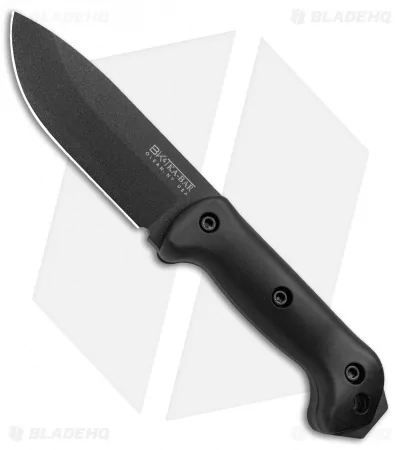
Fixed blade knives are made up of a continuous solid piece of metal with a handle. When the metal extends all the way throughout the handle, it is considered full tang. Full-tang fixed blade knives are the strongest knives. But, because they don’t fold, they take up a lot of space.
Pros:
- Strongest blade (especially when full-tang)
Cons:
- Because it can’t be folded, it takes up a lot more space
Our Pick: Ka-Bar Becker Companion
2. Folding Knife (Manual)
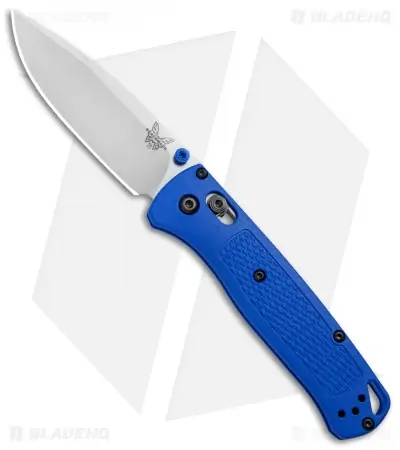
These knives are made of two main parts. The blade is on a pivot so it can open up. Usually, you flip the knife out with your fingers.
Pros:
- Fold, so take up less space
Cons:
- Pivot is a weak point, so not suitable for some tough tasks
- Often not made for left-handed people
- Take time to open
Our Pick: Benchmade Bugout AXIS
3. Assisted Opening
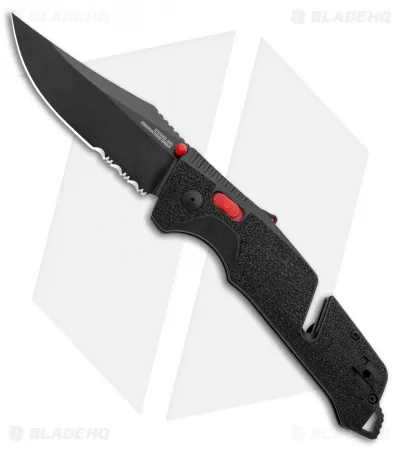
These are folding knives but they have springs inside of them. When you push a button on the back of the knife, the springs help push the blade out.
Pros:
- Can be deployed quickly
- Good for one-handed use
Cons:
- Illegal in some places
- Moving parts are prone to breaking
Check Out our favorite spring-loaded knives
Our Pick: SOG Trident Lock Knife
4. Automatic Opening

Also called switchblades, automatic opening knives are similar to assisted opening. The difference is that the blade will come all the way out.
Pros:
- Incredibly quick to deploy
- Fun factor
Cons:
- Illegal in some places
- Moving parts are prone to breaking
- Injury is possible if the locking mechanism breaks
Our Pick: Gerber 06 Automatic
Survival Knife Types by Carry Method
Next, think about how you want to carry the knife. While most survival knives are designed to be carried on your belt, there are some specialty types.
5. Boot Knives
Boot knives are made so they can fit comfortably in your boots. This means they usually aren’t more than 7 or 8 inches long total and have a thin handle.
Boot knives often have a spearpoint blade shape (though not always).
Pros:
- Concealed carry
- Blade still long enough to be functional
- Can carry on belt sheath too
Cons:
- Can be uncomfortable to wear
- Prone to getting dirty or sandy
See our picks for the best boot knives and how to wear a boot knife.
Our Pick: Gerber Ghoststrike
6. Wallet/Credit Card Knives
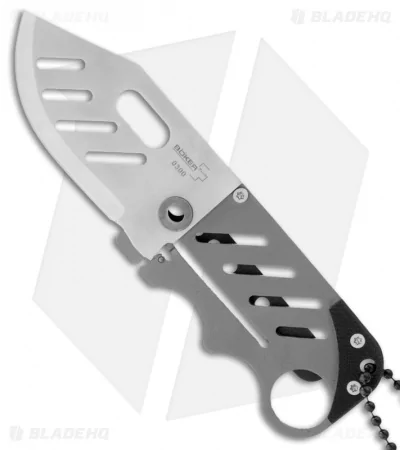
These are really tiny knives that can fit in your wallet. Sometimes they pop out of a plastic credit-card material.
Pros:
Cons:
- Easy to forget you are carrying and get into trouble during security checks
- Incredibly weak
Our Pick: Boker Plus Credit Card Knife
7. Neck Knives
Neck knives are especially popular with people who can’t carry a traditional knife – such as scuba divers and water rescue teams.
They are always small blades and have a good sheath to prevent accidentally stabbing. Wear them under your shirt so it doesn’t get snagged. Use a good chain. Or gut some 550 paracord and slide it over a metal bead chain.
Pros:
- Good for beach and water sports
- Concealed carry
- Lightweight
- Sometimes easier to access than a belt or pocket knife
Cons:
- Potential for serious injury if sheath fails
- Not always easy to access
- Choking risk
Check out our other favorite neck knives
Our Pick: Mtech USA Neck Knife
Survival Knife Type By Use
Some types of survival knives are better suited for certain tasks. A lot of this has to do with the knife blade shape. If you aren’t familiar with blade shapes, read this guide to knife blade shapes.
12. Combat
Combat knives are designed for hand-to-hand combat. This usually means a long blade with a very sharp point. Because they are so pointy, the tip won’t be very strong and thus not suited for tasks like batoning wood.
Pros:
- Good for piercing and stabbing
Cons:
- Tip is often very weak
- Often very large and bulky
Our Pick: Smith & Wesson 9″ Dual Edge Blade
13. Military Knives
The terms “military knife” and “combat knife” are often used interchangeably. However, military knives are not combat knives.
Rather, military knives are better suited for tasks like clearing brush or general utility. After all, the chance of a soldier getting into close-range combat with the enemy are very slim with today’s modern battle tactics.
Also, keep in mind that the US Military has used numerous different knives over the year (such as the M9 Bayonet).
The military also doesn’t have a “standard issue” knife it issues to all soldiers. The knives are unit property that are assigned to soldiers during training or tactical operations but then must be returned.
The exception is the “Yarborough” knife which is given to soldiers upon graduating from the US Army’s Special Forces school.
14. Throwing Knives
Throwing knives are getting very popular and are often marketed as a type of survival knife.
Let’s be honest though – you probably won’t ever need to throw a knife in a survival situation. There are better hunting weapons.
And, for self-defense, missing means you just gave your attacker a knife! But throwing knives can be a lot of fun to use. They also have a good point which is useful in some other situations,
Pros:
- Very sharp point
- Good for stabbing and self-defense
Cons:
- Not made for cutting or slicing
- Lacks versatility
- Weak tip breaks easily
See our favorite throwing knives
Our Pick: Cold Steel Pro Balance Sport
15. EMS/Rescue Knives
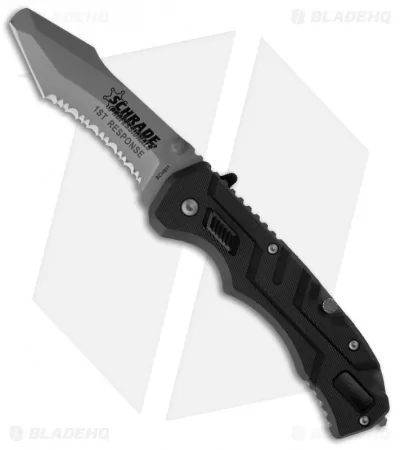
Even though EMS workers rarely use knives (trauma shears apparently get the most use), this is a common type of survival knife. They are always folding knives and usually have a few extra features like a glass breaker and seatbelt cutter – but not so many extra tools that they’d be considered a multi-tool. The blade shape varies but tanto blades are common. Many also have a partially-serrated blade.
Pros:
- Useful extra tools
- Good for EDC
Cons:
- Lots of cheap and gimmicky options
Our Pick: Schrade Assisted-Opening EMS Knife
Other Common Types of Survival Knives
Finally, there are some types of survival knives that have very distinct features in terms of length, blade shape, and function.
These are the main three you’ll hear about.
16. Bowie Knives
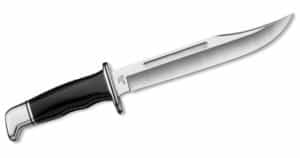
Bowie knives were originally designed in the early 1800s by the adventurer Rezin Bowie (he’s actually got a pretty cool life story worth reading). The knife became famous when his brother used it to kill someone during a large knife fight.
There are a lot of different Bowie knives but a real one should always be clip point, have a blade that is at least 5 inches long, and a full tang.
Pros:
- Versatile
- Good for heavy-duty tasks
- Good for self-defense
Cons:
- Large and heavy
- Not good for concealed carry
See our favorite bowie knives here
Our Pick: Buck 120
17. Rambo Knives
A lot of thought went into choosing the perfect survival knife for the Rambo movies.
The first three movies used a Bowie clip point blade with 14 saw teeth on the spine. The combo of these features makes the knife suited for tough tasks like chopping or sawing wood but also great for slashing and stabbing.
Our Pick: Officially Licensed Rambo II
18. Buck Knives
Buck isn’t really a type of survival knife. Rather, it is the brand name for a knife manufacturer which has been around since the 1600s. They popularized a specific style of knife in the 1960s. Now that style – even when it isn’t made by the Buck company – is called a Buck knife.
Buck-type knives are folders with a lockback – they have a notch that holds the blade in the open position so it is less likely to close on you and cause injury.
The original Buck 110 had a clip-point blade, which is very versatile. But be aware that the brand Buck makes a lot of knives that don’t have these features.
Note: Many knife brands have become so iconic that they are considered a type of knife. For example, KA-Bar knives, Kershaw, Spyderco, Benchmade, and Boker.
Pros:
- Locking mechanism prevents injury
- Strong for a folding knife
- Versatile
- Good for EDC
- Affordable knife brand and made in the USA
Cons:
- Lots of cheap buck knives out there
Also check out our other favorite buck knives
Our Pick: Buck 110
[ad_2]
Source link